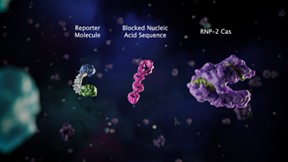Written by A. Hammouda: VedaBio, has unlocked the true potential of CRISPR for molecular detection via the CRISPR Cascade™, a revolutionary platform derived from the intersection of engineering and biology. VedaBio’s CRISPR Cascade is a disruptive new molecular detection platform that operates with a combination of unprecedented speed and accuracy. The CRISPR Cascade platform eliminates the need for target amplification while maintaining PCR-level accuracy, all with an analytical turnaround time of less than one minute.
How the CRISPR Cascade works
The CRISPR Cascade is a powerful tool for detecting specific sequences of DNA or RNA in a sample. It uses two ribonucleoproteins (RNPs). RNP1 is a Cas enzyme that works together with a guide RNA that matches the sequence you want to find. Unlike other methods that need to amplify the target sequence first, the CRISPR cascade uses reporter molecules, blocked nucleic acids, and another Cas enzyme (RNP-2 Cas) that triggers the cascade reaction. Here is how it works:
Upon sample introduction, the cascade starts when RNP-1 Cas identifies the target sequence present. RNP-1 Cas binds with the target, activating the RNP-1 complex. The RNP-1 complex begins to cut any nearby DNA or RNA. Activated RNP-1 complexes will cut both the reporter molecule, releasing a fluorescence signal, and the RNP-2 blocked target, releasing a complementary target that can activate RNP-2 complex. Like the RNP-1 complex, the activated RNP-2 complex can cut both reporter molecules and more blocked RNP-2 targets. This generates an exponential cascade effect that leads to a positive feedback loop of RNP-2 complex formation and reporter activation. This produces a robust, easily detectable signal, almost instantaneously.
Merits of the new molecular detection tool
The new technique is target-amplification-free. The use of multiple Cas enzymes, blocked nucleic acid sequences, and reporter molecules generates robust signal without the need for target amplification.
The CRISPR cascade activation results in a positive feedback loop that produces analytical reaction times of less than one minute. It can be used with a wide variety of reporter types including fluorescence and colorimetric.
Another merit is room temperature assay functionality. The assay shows robust, reproducible performance at room temperature.
Unlike PCR or other DNA amplification technologies where pooling of primers for multiplexing can negatively impact sensitivity and specificity of the assay, the CRISPR cascade has the unique ability to pool different RNP1s together, enabling massive multiplexing without signal loss or cross reactivity issues.
With performance that combines highly sensitive, accurate, and near-instant results, the CRISPR cascade unlocks a universe of limitless possibilities: diagnostics, therapeutics, research, and other applications.
Source:
VedaBio | Discover the Power of CRISPR for Molecular Detection
See also:
